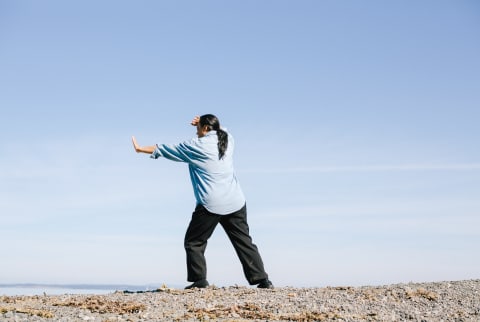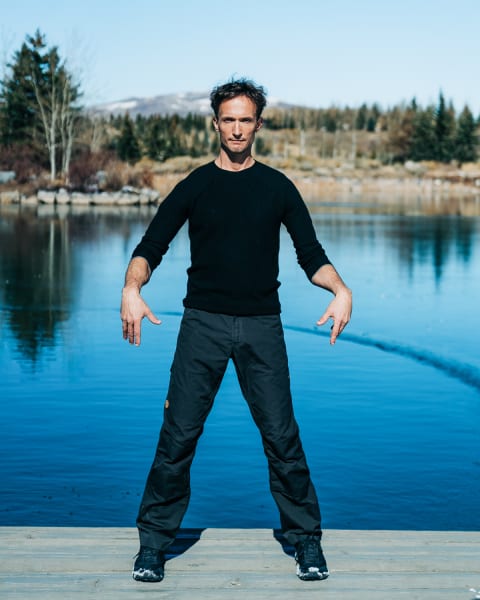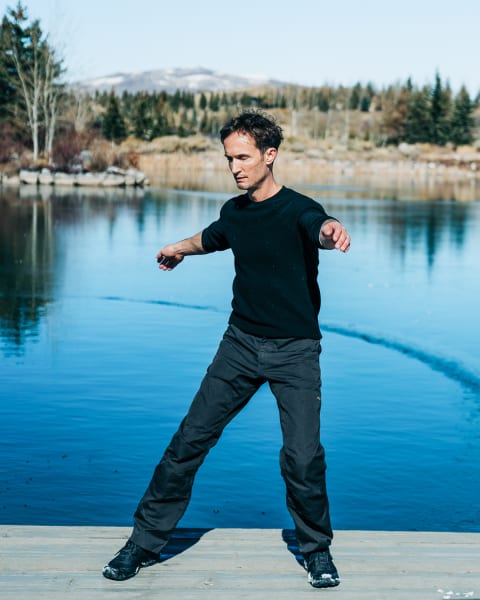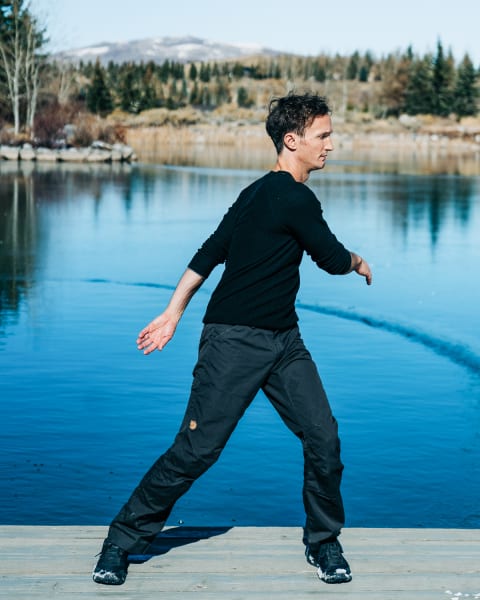Advertisement
Tai Chi For Beginners: 3 Movements To Try, From An Instructor


One of the things I love about tai chi is, you can be better at tai chi when you're 40 than when you were at 20, and again when you're 80 than when you were at 40. Because it's a practice of sustainability, moving in a way that depends less on force and control, more on ease and harmony.
Another thing I love is the point of tai chi practice isn't to be good at it. Tai chi is a practice for creating a good connection with your self, and your whole environment, so you can do better at whatever it is you love doing.
This brings me to a third thing I admire about this ancient practice: What you see isn't what you're practicing. For so many of us, our first look at tai chi might have been a group of older people in a field, all moving together in this peaceful-looking choreography. This is called tai chi chuan—a sequence that is shared the same way every time.
But tai chi isn't this sequence, or a set of static poses to memorize. This is really good news if you're a beginner, naturally worried about so many complex positions to remember. The foundations you're always practicing in tai chi have nothing to do with memorizing or copying.
Tai chi practice is in how you are right now, and how you get where you're going next. Because how you get where you're going creates the experience you have when you arrive. The forms and sequence in tai chi give a foundation for practice, but they are never rigid or static and require much less memorization. It's how you go from one place to the next—so your tai chi is always fluid, responsive, and adaptable. Tai chi isn't for tai chi; it's for real life.
Whether you're just beginning tai chi, or maybe beginning again with a new perspective, there are three simple practices you can always use that give you the right foundations for progress. They have many names, but here let's call them the shake, shimmy, and swish.
Shake

This movement is for summoning your chi, or you can just simply say "waking up." Either way, its purpose is simple: Notice what's going on in your body. This movement shows where your energy is flowing easily and where it's held back by rigidity and tension, so you have a chance to make things better.
How to: Begin just by standing like a human being, without any special techniques or practices in mind. Now give your whole arms a good shake, from the center of your elbow radiating down into your fingertips, and out through your whole body. Notice where you can feel this shake. Does the wave that begins in your elbows move through all of you? Or does the feeling of movement and vibration end in some part, so it goes only as far as your shoulders, or your upper body?
Why it's important: Wherever you hold too much tension and effort, energy is blocked, so it can't move beyond this point. If your shoulder is a little lifted, your arm movements will end here. Or if your thighs and knees are locked in place, you might feel a shake in your upper body but nothing below your waist.
When your energy is blocked this way, it means you'll need to work twice as hard to keep even simple movements and tasks going. So when you find these places, you have a wonderful opportunity to let the extra effort and tension go and reconnect your body together as one whole unblocked body, which makes everything a lot easier.
Shimmy

This movement is for making sure you are movable before you try to move. So often some part of us can be a little tense, a little disconnected from our other parts. And when we try to move with this extra tension and disconnection, everything becomes much harder. So it's extremely useful to connect your whole body together as one whole body working in harmony, which means every part of you helps every other part. It's your way to literally be all that you can be.
How to: Just like the first practice, this one is simple, works wherever you are, and doesn't take a lot of time. Just stand like a human being, feet about shoulder-width apart, knees relaxed, no special techniques here. Now beginning from your belly (or center), roll continuously around from side to side, so a shimmy runs out through your arms, legs, and your whole body.
If you put more energy into a bigger shimmy, your feet will slide naturally apart to create a more stable and supportive base, and your arms will fly around through bigger movements. If your shimmy is smaller, your feet might slide closer together and your arms will just slide around your body from side to side. Either way, if your whole body doesn't respond to your shimmy from the center, you have a wonderful chance to see what's immobilized in you and set it free.
Why it's important: This shimmy is something you might see a kid do, just to shake off a fall or something scary. And that's because this movement, like most of tai chi, is written into our biology. It's simply a good way to let go of excess stress and tension and get everything we have working efficiently together.
Swish

This is a practice for being moved, which in tai chi is an important way to accomplish two things. One is, it allows you to let go of force and control as the only way to achieve everything. And the other is, it allows at least half of you to rest and replenish at all times, even in the midst of great challenge.
How to: Begin standing here, just like a regular human being, no special form or technique needed. Give yourself a shake and shimmy, just to make sure you're movable before you try to move more. Now begin rolling your belly (or center) toward the left and then right, and keep going with this side-to-side rolling movement.
If you put more energy into this side-to-side rolling from your center, allow your feet to slide naturally apart, to create a wider and more supportive base. And whether your movements are big or small here, allow your arms to go along for the ride, without trying to control them. This will let your arms swing from side to side, having an impact on your body as you change direction, which gives a perfect therapy for the constant tension of everyday work.
If your knees are locked, unlock them, so your weight can shift easily over one leg and then the other. If your thighs are working hard to push you from side to side, think more of moving from your center. As you roll from side to side, this allows you to pull your weight out of one leg and then the other rather than push. So your unweighted leg now has a chance to completely release, relax, and let go of effort.
Why it's important: This practice of unweighting before effort is extremely useful in tai chi. In the middle of hard work, it gives these working parts of you a wonderful chance to return to their effort always rested and ready for more rather than depleted from constant pushing and tension.
The takeaway.
Through all of tai chi, there's one more crucial element to remember: This practice is not to be perfect. It's to see what's happening in us, as we try to be where we are and go where we want to go.
If all we saw in ourselves was perfection, we wouldn't have much chance to make things better. Tai chi puts us into a scientist's perspective, so we can delight in discovering where we are imperfect in an idea or practice. It's in this discovery of imperfection that hope for something better begins. And tai chi gives us a practice for carrying us there.
Michael Taylor is a mind-body movement expert, martial artist, and the co-founder of Strala Yoga. In his mbg class, The Complete Guide to Tai Chi: Everyday Practices To Drop Stress, Release Pain & Create Whole-Body Harmony, you'll learn not only the basics of tai chi but how to use it to achieve your goals and dreams with ease.